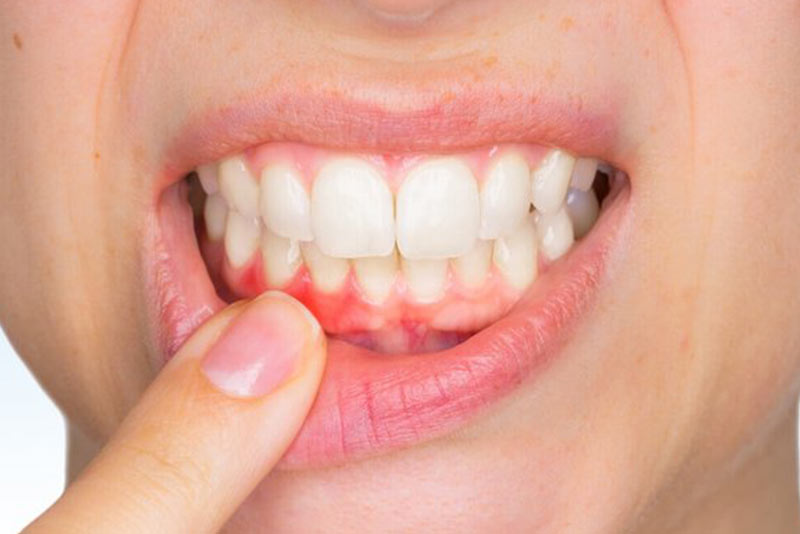
What are the Causes of Gum Diseases?
The main cause of gum diseases is a sticky, transparent layer called bacterial plaque that adheres tightly to the teeth. One milligram of plaque contains between 200 and 500 million bacteria. In addition, the following factors seriously affect gum health:
- Genetic factors,
- Smoking,
- Medication use (birth control pills, antidepressants, heart medications, etc.),
- Hormonal changes (pregnancy, menopause, menstruation, etc.)
- Stress,
- Teeth clenching and grinding,
- Unbalanced diet,
- Diabetes,
- Poorly done intraoral procedures (crowns, bridges, and fillings)
How are the Symptoms of Gum Diseases Seen?
Periodontal diseases are responsible for 70% of tooth loss in adults. These diseases can be treated easily and successfully when diagnosed in the early stages. Prevention or treatment of gum diseases also brings other benefits such as the preservation of natural teeth, more comfortable chewing, and better digestion.
There are many findings of gum disease:
- Bleeding gums during brushing,
- Red, swollen, and sensitive gums,
- Gums that can be easily separated from the teeth, receding gums,
- Inflammatory discharge between teeth and gums,
- Black areas at the gum edges or between the teeth due to tartar,
- Changes in the relationships between lower and upper teeth during biting,
- Changes or deterioration in partial denture fit,
- Persistent bad breath and a bad taste sensation.
What is the Effect of Tartar Cleaning on Preventing Gum Diseases?
Periodontal diseases begin with gingivitis, and the most important factor in this is dental plaque. Tartar forms with the calcification of dental plaque. Tartar has a rough surface and is always covered with uncalcified plaque. Thus, tartar provides a suitable environment for plaque, causing inflammation to persist and worsen. This bacterial plaque, which causes gum problems, needs to be removed regularly every day from the teeth with brushing, flossing, and chemical agents. Daily oral care keeps tartar formation to a minimum but cannot completely prevent it. Therefore, formed tartar must be cleaned. This is not a harmful or dangerous procedure for the teeth. The recurrence of tartar can be prevented with effective oral care. Sensitivity and some bleeding in the teeth may occur after tartar cleaning, and this is normal. After tartar cleaning, the surface is exposed, and sensitivity to cold and heat occurs on this exposed surface. This sensitivity is expected to disappear in 3-4 days.
What Should Be Done After Surgical Intervention on the Gums?
Surgical intervention may be necessary in advanced cases of gum problems. The aim of surgical intervention is to smooth the root surfaces and shape the gums for easy cleaning by removing tartar and diseased tissues in deep pockets so that healing can occur. The things to pay attention to after these surgical interventions are as follows:
- Do not eat or drink anything for 2 hours after the surgical procedure.
- You should avoid hot food and drinks within the first 24 hours. Chewing should be done with the area not included in the operation. Soft and warm foods are suitable. Acidic fruit juices, alcoholic beverages, and spicy foods should be avoided. Otherwise, they will cause pain.
- Smoking should be avoided in the days following the surgery. Smoking should not be done after the surgical procedure as it will irritate the gums, endanger healing, and increase the intraoral temperature.
-
For 2 weeks following the surgery, prostheses, if any, should be used as little as possible.
- If there is no patch in the operated area or if it falls off, the lip and cheek should not be lifted to look at the sutures.
- The patch placed on the surgical area is to make you comfortable and protect the wound area from irritation. It prevents pain, facilitates wound healing, and allows you to comfortably continue your usual activities. The patch may feel uncomfortable in the first few hours after it is placed. Do not play with the patch with your tongue or fingers. Do not panic if the placed patch breaks into small pieces. If large pieces come off or if it bothers you a lot, call your doctor.
- Mild swelling may occur. You can apply an ice pack externally on the operated area by preparing it on the first day. Rinse your mouth gently with a glass of lukewarm water with a teaspoon of salt frequently.
- A small amount of leakage from the surgical area may occur within the first 4-5 hours after the operation. This will give your saliva a red color. Do not panic in this case, and if the leakage continues, you can roll a clean gauze pad and apply pressure to the bleeding area for about 20 minutes. Longer-lasting bleeding should be controlled by your doctor.
- A feeling of chills and weakness may occur within the first 24 hours after the operation. This is normal and there is no need to worry. You can continue your daily activities, but strenuous sports should not be done.
- Follow the prescription written by your doctor for post-operative healing. If your doctor has recommended it, use antibiotics as prescribed. You can take painkillers if you have pain after the operation. In this case, aspirin or similar salicylic acid derivative drugs should not be taken.
- You can apply normal brushing procedures to the non-operated areas. Brush the chewing surfaces of the teeth in the operated area. If a patch has not been applied, you can also brush the teeth in that area. However, do not go under the gum line when using dental floss. If your doctor has recommended it, you can use the recommended mouthwash after brushing.
-
Rinse your mouth after eating. You can wipe the surface of the patch with a damp cotton ball or ear cleaning stick.
- Call your doctor to have your stitches removed and for a check-up at the end of the period recommended by your doctor (1 week or 10 days).
